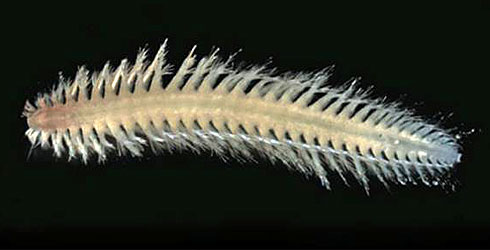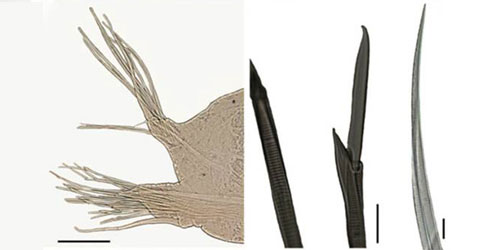Vigtorniella ardabilia (carpet worm)
Vigtorniella ardabilia is a species of annelid worm found on the sea floor in areas of organic enrichment. These habitats include the remains of dead whales on the sea floor (whale-falls) and areas of polluted sediment found underneath fish farms.
This new species was only discovered and described in 2009. It was one of many thousands of new marine species that are described every year.
One of the interesting things about Vigtorniella ardabilia is that it is what scientists term a cryptic species. These are species which appear morphologically the same as a closely-related species, and are distinguishable only on the basis of their DNA sequences.
Species detail
In 2004, scientists described a new species of annelid worm, Vigtorniella flokati from a deep-sea site in the north Pacific. The animal was found feeding on the remains of a large gray whale carcass, Eschrichtius robustus, at a depth of 1600m off the coast of California.
The species was named for the genus it belonged to, Vigtorniella, and the new name, flokati, was chosen based on the shag-pile carpets of the same name, derived from the Greek word for flokati. The name was appropriate as the species formed carpets over the surface of the whale bones they were found on.
In 2008, a species identical to V. flokati was found on the remains of another whale carcass in a fjord off Sweden, Kosterfjord. This was very surprising as it was from a completely different ocean basin and much shallower, at only 30m depth. The scientists were also given some samples from a fish-farm in Norway, where strange worms had been found feeding on the organic remains underneath the fish cages.
It was only when DNA sequences were studied that it was realised that the species from the Norwegian fish farms and the Swedish whale-fall where the same species, but different from the deep north Pacific species.
The scientists decided to name the new ‘carpet worm’ species Vigtorniella ardabilia, after another carpet, the famous Ardabil carpet housed in the Victoria & Albert Museum, next door to the Natural History Museum.
-

Taxonomy
Discover the features that give Vigtorniella ardabilia its fluffy appearance and learn about the process that led to it being named a new species.
-

Distribution and habitat
Find out where Vigtorniella ardabilia has been recorded and the types of habitat it has been found in.
Images

Vigtorniella ardabilia, a new species of ‘carpet-worm’.
© A Glover
Vigtorniella flokati forming ‘flokati-rug’ type mats on the sea floor.
© A Glover
Detail of a shag-pile carpet, commonly known in the trade as flokati rugs.
© A Glover
A detail of the chaetae (hairs) on the side of Vigtorniella ardabilia reveal the reason for its fluffy, carpet-like appearance.
© A Glover
Detailed population genetic analyses can help us determine new species, and understand patterns of dispersal.
© A GloverAbout the author

Dr Adrian Glover
Marine biologist focussing on deep-sea biodiversity, systematics, evolution and ecology of polychaetes.
